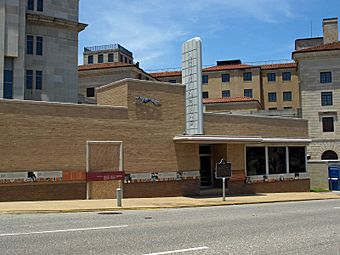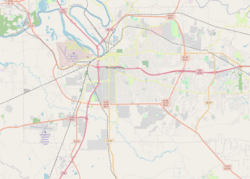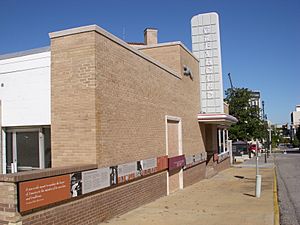Freedom Rides Museum facts for kids
Quick facts for kids |
|
|
Montgomery Greyhound Bus Station
|
|

The Greyhound Bus Station in 2009
|
|
| Location | 210 S. Court St., Montgomery, Alabama |
|---|---|
| Built | 1951 |
| Architect | W.S. Arrasmith |
| Architectural style | Streamline moderne |
| NRHP reference No. | 11000298 |
| Added to NRHP | May 16, 2011 |
The Freedom Rides Museum is in Montgomery, Alabama. It is located at 210 South Court Street. This building was once the Montgomery Greyhound Bus Station until 1995.
This place is very important in American history. It was where brave people called Freedom Riders faced a violent attack in 1961. These events were a key part of the Civil Rights Movement. The attacks in May 1961 shocked the country. They made the Kennedy Administration support civil rights activists for the first time.
The building is no longer a bus station. It was saved from being torn down, and its outside look has been fixed up. The Alabama Historical Commission now manages the site. A special marker tells its history. In 2011, a museum opened inside the building. It was also added to the National Register of Historic Places. This list recognizes important historical places in the U.S. The museum even won an award in 2012 for its preservation work.
Contents
Building the Bus Station
In 1950, Greyhound Lines decided to build a new bus station. They hired an architect named W.S. Arrasmith. The new station was in Montgomery, Alabama. It replaced an older station nearby.
The building had a modern, sleek design. It featured a tall "Greyhound" sign that lit up with neon lights. This station was a typical example of Greyhound stations from that time. It opened in August 1951.
The bus station became famous because of what happened on May 20, 1961. At that time, the station had a separate door for African Americans. It was labeled "Colored Entrance." Black passengers had to enter through this door. They went directly into the bus area. They could only access the inside of the station from the back. This showed the unfair rules of segregation.
The Freedom Rides: A Journey for Justice
Freedom Riders were brave people who fought for civil rights. In 1961, they rode buses across the southern United States. These buses were still segregated, meaning Black and white people were kept separate. The riders wanted to challenge these unfair rules. They knew the Supreme Court had already said segregated buses were against the law.
The Congress of Racial Equality (CORE) organized these rides. Mixed groups of Black and white riders sat together on Greyhound and Trailways buses. Their journey started in Washington, D.C. and was supposed to end in New Orleans. They planned to stop in Alabama cities like Anniston, Birmingham, and Montgomery.
Attacks in Anniston and Birmingham
The Freedom Ride faced serious trouble in Alabama. In Anniston, a large group of angry white people attacked the Greyhound bus. They set it on fire. The riders inside were badly beaten. An hour later, the Trailways bus arrived. Members of the Ku Klux Klan boarded it and beat the Freedom Riders.
The Trailways bus was also attacked in Birmingham. Several riders, including James Peck, were beaten. News of this violence reached U.S. Attorney General Robert F. Kennedy. He asked the Freedom Riders to be careful. He also sent an assistant, John Seigenthaler, to Birmingham. CORE decided to stop the Freedom Ride in Birmingham on May 14. The remaining riders flew to New Orleans.
Nashville Students Continue the Ride
Even after the attacks, some students were determined to continue. Diane Nash and 20 other young students decided to take their place. Most of them were from Nashville, Tennessee, and many attended Fisk University. John Lewis, who later became a famous civil rights leader, was one of them.
Greyhound first refused to let any of their drivers take the bus. But after Robert F. Kennedy got involved, a driver was found. Floyd Mann, Alabama's Director of Public Safety, provided state troopers to escort the bus. On May 20, the bus left Birmingham for Montgomery.
Violence in Montgomery and Federal Help
As the bus reached Montgomery, the state troopers left. The riders arrived at the bus station at 10:23 AM. A large, angry crowd of white protesters was waiting. This crowd included women and children. They violently attacked the Freedom Riders.
Many riders were hurt. Robert Kennedy's assistant, John Seigenthaler, was also injured. He tried to help two white female riders. He was hit with a metal pipe and knocked unconscious. Floyd Mann, who had stationed his troopers nearby, stepped in to help. He protected William Barbee, who was badly beaten. Mann fired his gun in the air, shouting, "There'll be no killing here today." He even saved Jim Zwerg from another attack. Soon, Mann's troopers arrived to control the crowd.
On Sunday, May 21, Martin Luther King Jr. and other civil rights leaders came to support the Freedom Riders. That evening, they held a service at Ralph Abernathy's First Baptist Church. Outside, about 3,000 angry protesters yelled. They burned a car and threatened to burn the church.
From inside the church, Dr. King called Robert Kennedy. Kennedy asked the activists to "cool down," but they refused. Kennedy then sent 500 U.S. Marshals to Montgomery. These marshals, with help from Floyd Mann and his troopers, kept the mob away. The National Guard finally helped break up the crowd at midnight.
On May 24, the Freedom Ride continued. Riders boarded buses from Montgomery to Jackson, Mississippi. In Jackson, the students were arrested. They tried to use the "Black" and "White" waiting rooms together.
Because of the unrest and the national attention, Robert Kennedy took action. He asked the Interstate Commerce Commission to make stronger rules. These rules helped end segregation in interstate travel. A court order was also issued against the Ku Klux Klan by Judge Frank M. Johnson. His courthouse was right behind the Greyhound station.
Bus Station Closure and Preservation
The Greyhound station closed in 1995. A historical marker was placed there in 1996 to remember its past. For a while, the station was not well cared for. Plans to open a museum were delayed.
In 2008, special panels were put on the outside of the building. These 15 panels used pictures and words to tell the story of May 1961. However, people still could not go inside the building.
In 2009, architects were hired to fix up the inside of the bus station. Their goal was to turn it into The Freedom Rides Museum.
In May 2011, the museum officially opened. This was 50 years after the riot at the bus station. It is a 3,000 square foot museum. The building was also added to the National Register of Historic Places on May 16, 2011. The museum chose to show how the building was designed for segregation in its exhibits.
In May 2021, the museum showed a restored Greyhound bus. This was to honor the 60th anniversary of the Freedom Riders. The 1957 model bus was like those used during the Freedom Rides in 1961.
Recently, in early March 2025, a government group suggested selling the museum property. This property is part of the National Parks Civil Rights Trail. Local leaders strongly disagreed with this idea.
See also
- Freedom Riders National Monument, Anniston, Alabama






